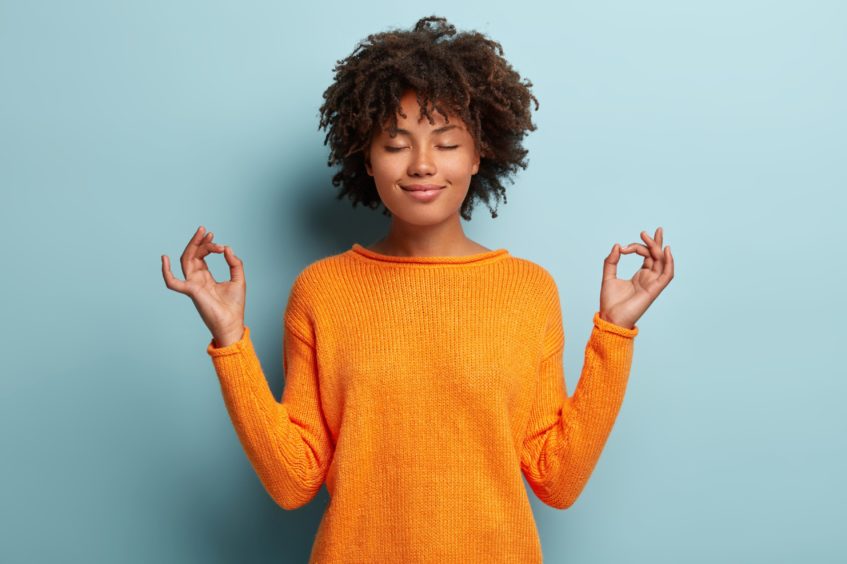
Stressed? Anxious? Angry? Practiced for thousands of years, yoga has a range of restorative powers and, with regular practice, you could enjoy better physical and mental health. In addition to improved posture, strengthened muscles and increased flexibility, expert yoga teacher Christine Burke, shares key poses for everyday concerns.
Warm up
Sun Salutations (Surya Namaskar) B variation
Use this warm up before trying the remedies below – it’s the least strenuous version of the Sun Salutation movement.
1. Stand in Tadasana with your feet together or hip-width apart, and bring your hands together in prayer position over your heart centre (Anjali Mudra).
2. On an inhale, sweep the arms out to the sides and overhead. As you exhale, bend forward from the hips into Standing Forward Fold. Bend your knees if your back is tender.
3. Inhale and lift up your chest, lengthening your spine. Your arms are straight, and your hands are touching either the floor or your shins. This is a Standing Half Forward Fold.
4. Exhale and fold forward again into a Standing Forward Fold.
5. Inhale to lift up your arms and bend at the hips, knees, and ankles, lowering your rear while stretching the torso upward. Exhale. Keep your arms active and in line with your ears – don’t let them drift forward. This is the Chair or the Powerful Pose. Hold for 1–3 breaths.
6. On your next inhale, lift straight up to standing, pushing firmly into your feet, arms stretching to the sky. Exhale as you bring your hands back to prayer position over your heart center (Anjali Mudra). Let your breath guide you into a rhythm and repeat as many times as you like with a minimum of five cycles.
For anger
Lion’s Breath (Simhasana)
Hansi Mudra and Dirga breath
You may feel silly and awkward as you get used to roaring like a lion, but a little silly can go a long way to soothe an angry beast. Also, this breath tones the throat and neck (even lions appreciate a youthful appearance), strengthens the platysma muscle at the front of the throat, releases jaw tension, and activates the bandhas.
1. Choose your position: sit with big toes together and knees open, sit on your heels, or even lunge forward like a pouncing lion.
2. Take a big inhale, and as you forcefully exhale spread your hands like giant paws with claws, press them down into your legs or the floor, and simultaneously stick your tongue out and roll your wide-open eyes toward your third eye. Freeze for 20 seconds in the pose. Then relax and breathe normally. Repeat twice.

For headaches
Child’s Pose (Adho Mukha Virasana)
Ah, the wisdom of the child. This pose is always a wise choice to elevate your body and spirit. It can be done on the floor, with a few props or makeshift accessories if they make it better for you. Follow the instructions below and stay in the pose for as long as you like.
1. Start on hands and knees and bring your big toes together, shifting your knees apart so that they are wider your hips.
2. On an exhale, draw your navel toward your spine, creating a dome in your back, as you ease your hips on to your heels. This creates more space in the lower back.
3. Once you are settled, allow your back to flatten out naturally as you nestle into the pose. Your forehead is on the floor with your chin tucked in and the back of the neck long. You can leave your arms stretched out in front of you, hands flat on the floor and fingers spread wide like starfish, or lay them alongside your legs with your hands near your heels, palms up.
4. If your hips are high or you have trouble reaching the floor with your head, use a support, such as a folded blanket or block, under your forehead. If this pose is uncomfortable for your knees, you can use a bolster or folded blanket as a support – pull it into your pelvis and lay your torso along the support with your head turned to one side; your arms can be alongside your body with the palms facing up, or bring them forward, bend the elbows and “hug” the bolster.
5. If your knees are still uncomfortable, roll up a blanket, towel, or article of clothing and place it snugly behind both knees before lowering your hips.
For anxiety
Hansi Mudra and Dirga breath
Hansi Mudra promotes a feeling of courage and fearlessness and is wonderful for anxious minds and feelings of isolation.
1. Sit on the floor or chair. Bring thumb, index, middle and ring finger together on each hand. Extend your pinky. Place the back of the hands on your thighs or knees. Close your eyes.
2. Begin Dirga Breath. Inhale into the bottom of your belly, then your solar plexus, finishing the breath in your chest. You may find it helpful to visualise filling a glass with water from the bottom to top.
3. Pause briefly when you have filled your glass then exhale from the upper chest, solar plexus, and finally bottom of the belly as if you were pouring the water from the glass. Continue with Dirga for 1-3 minutes.
For cramps
Reclining butterfly (Supta Baddha Konasana)
You can practice this lying flat on the floor, or with the support of a bolster or folded blankets.
1. Sit on the floor, spine straight, and bring the soles of your feet together, having placed your support to come right up against your low back. Draw your tailbone underneath you, as if you are smoothing out your skirt to sit down, and then lower your back on to the support. You may want to have a blanket or pillow under your head.
2. If the stretch feels too much for your hips or knees, place blocks, books, or rolled-up blankets under the outer knees. If the stretch is too extreme for your back, place a block or books under your support where your upper back lands.
3. Soften into the asana (body posture) by focusing on your breath in your belly. Take easy, natural breaths and visualize yourself floating in water.
4. By releasing tension in the hips and gently stretching the abdomen, this pose restores harmony to the second, sacral chakra. It activates and restores our senses of power and comfort, easing anxiety and pacifying an irritable mind. Stay for five minutes, or as long as you feel bliss.
Extracts from Yoga for Everyday Life, photography by Erika Flores, Ryland Peters & Small, £14.99

Enjoy the convenience of having The Sunday Post delivered as a digital ePaper straight to your smartphone, tablet or computer.
Subscribe for only £5.49 a month and enjoy all the benefits of the printed paper as a digital replica.
Subscribe